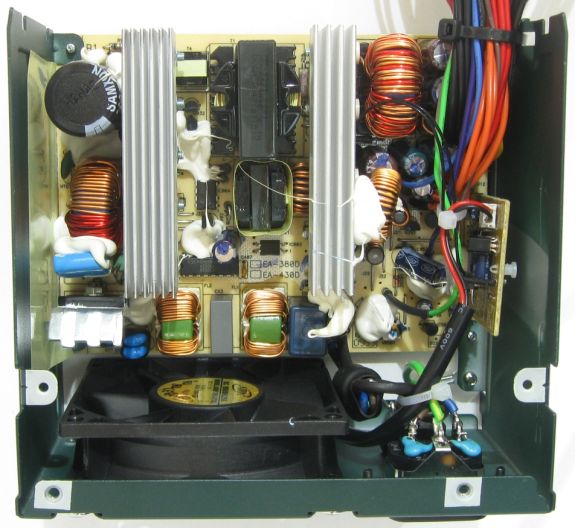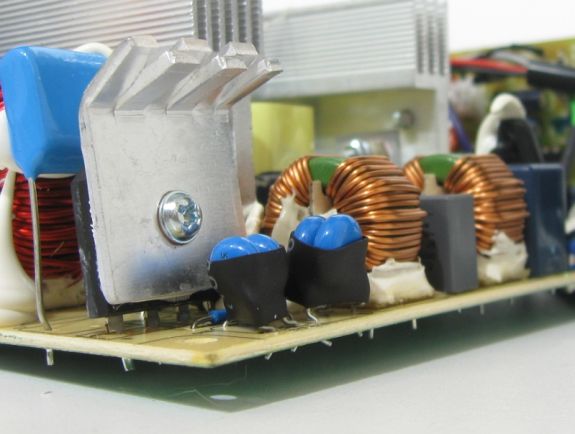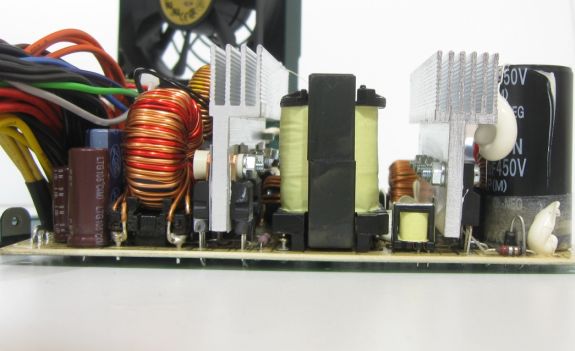Antec EarthWatts EA 380D Green 380W
by Martin Kaffei on October 2, 2010 7:00 PM EST- Posted in
- Cases/Cooling/PSUs
- PSUs
- Green
- Antec
- Earth Watts
- 380W
Internals
After opening the PSU, a well-structured design can be seen with two rather slim heat sinks, which are positioned according to the airflow. Similar to the first EarthWatts models (designed by Seasonic), the heat sinks don’t form a tunnel topology, which means that the airflow isn’t as linear as we have seen elsewhere--i.e. an Arctic Cooling PSU with their thoughtfully positioned air foil. But there is less energy dissipating into heat because of the lower nominal power and higher efficiency and there are large spaces inside where the air is able to circulate. The position of the rectifier bridge with its heatsink and the EMI-filter slightly hinder the airflow.
The IEC-plug is followed by the mains switch, which engages the phase conductor when thrown. Two Y-caps are connected with a protective ground wire, which is securely fixed on the case. Additional glue would be useful to improve mechanical stability. Well-twisted phase and neutral wires are coiled around an additional ferrite core and securely soldered. If wires are not twisted well, the connection could easily break. [Note: The quality in Chinese factories is still fluctuating.]
Two common mode chokes, four Y-caps, and two X-caps follow, with another X-type cap located behind the rectifier bridge; however, a varistor is missing. From this perspective we can see how precisely the chokes are fixed. In the power factor pre-regulator, we find a Samxon capacitor with the model number MXL. The Champion-IC 6800AG regulates the PFC and the main circuit of the PSU. This IC features OCP (Over Current Protection) and short circuit protection and has become popular because of its low-loss controlling.
Since the glue can’t always be positioned accurately, the 12V-choke is stabilised with a socket, which is useful at certain sizes. The costs are higher and the processing is more complicated. This kind of fastening is more likely to be found in high-end models. Sometimes this method is impossible, since the space is limited. The last model with this feature was the Enermax Revolution85+ 850W, where the size of the PFC-choke was the problem. In the OEM sector it is common to fix the components above necessity.
The +12V rail is filtered by Nippon Chemi-Con (KZE) and Ltec (LZG) capacitors, while on the smaller rails a potpourri of Nippon Chemi-Cons, Ltecs, and a single Taicon are used. A metering diode on a heat sink measures the temperature.
The noted build quality continues with a high soldering quality. Most conducting paths are cleanly soldered, but the output cables of the secondary circuit had to be cut so the wires don’t protrude too much under the PCB. Usually the manufacturer should be able to estimate the lengths of the wire when using THT-components. Connections could break if protruding wires are cut off. On the solder points of phase and neutral wires, solder residue can be found because of a very high soldering temperature, but there are no damages visible.














64 Comments
View All Comments
8steve8 - Saturday, October 2, 2010 - link
power consumption of 0.25A.azimex - Saturday, October 2, 2010 - link
Ok, its current drawn . Txs for pointing it out.gvaley - Wednesday, October 6, 2010 - link
I've seen worst. For example, "The current's power is 220V." :-)fausto412 - Saturday, October 2, 2010 - link
Ok, everyone who reads Anandtech and can use one of these 380W PSUs in any of your current or future rigs please raise your hand. anyone? hello? (crickets) anybody?Who thought it wise to waste their time reviewing this? I won't even read it.
DanNeely - Saturday, October 2, 2010 - link
Everyone who builds HTPC's raises hands and applies cluebats.bwj - Saturday, October 2, 2010 - link
I have a Core i7 CPU, 12GB of memory, six hard drives, three SSDs, and two video cards with a 300W power supply.Samus - Saturday, October 2, 2010 - link
I enjoyed the review, especially its technical component layout. It's nice to see Antec is making quality affordable, unlike PCP&C which makes quality unaffordable :)najames - Saturday, October 2, 2010 - link
I think you'd be surprised at the number of people using this size of power supply or even smaller. A lot of people even run dinky Pico power supplies. I have a couple rigs using 330W Seasonics, but I should be using even smaller supplies. I don't play ANY video games onboard video is fine for media server, or computers that crunch data.If I have a media server with a i3 530 that draws 35W idle and 100W load, I'd want a small power supply to make it run in the 80% efficiency range if possible. I'm looking to build a new one and am going to read the article. Even if it is not the power supply I want, I might still learn something.
mindless1 - Saturday, October 2, 2010 - link
The only system you should need a > 380W PSU in is your gaming rig. Since you can't play games on more than one system at a time, the rest of your systems won't need it unless you're a quite extreme overclocker.Leyawiin - Saturday, October 2, 2010 - link
I appreciate this review. I build a lot of basic PCs for friends and family that don't need what I have.